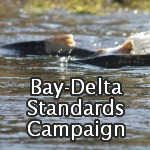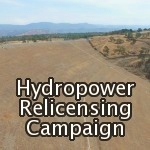Article from Red Green and Blue.
http://redgreenandblue.org/2021/05/25/californias-endangered-chinook-dying-can-spawn/
Published on May 25th, 2021
By Dan Bacher
Over 30 years ago, my boss, Hal Bonslett, and I went to meeting after meeting and wrote article after article demanding that winter-run Chinook salmon be listed under the federal and state Endangered Species Act. The fish was finally listed under both state and federal law, yet winter Chinook are now dying before spawning below Keswick Dam.
On Friday, May 21, the California Department of Fish and Wildlife (CDFW) reported that endangered winter-run Chinook salmon are dying from exposure to water released from Shasta Dam that is too hot. Fish that haven’t succumbed to the high temperatures yet are covered with fungus and are struggling for oxygen. The report states:
“5-21-21. Carcass counts [along the Sacramento River between Keswick Dam and Balls Ferry Brg] have increased although a large number of these observations have been pre-spawn mortalities. Crews continue to observe live fish that are exhibiting unusual swimming behavior, fish covered with fungus patches, and unspawned fish drifting downstream while still alive but moribund and presumed to die shortly after observation. To date of the 66 carcasses observed 25 have been unspawned (16 of these were females). Water temperatures have cooled in the upper river earlier this week as power bypass operations have been reduced and much cooler weather has prevailed over the past days.”
“Why, you might ask?” asked Mike Conroy, Executive Director of the Pacific Federations of Fishermen’s Associations (PCFFA). “It was because Bureau of Reclamation released water that was too hot. When Reclamation did their power bypass operations earlier this month, NMFS and CDFW told them to keep water temperatures below 60 degrees at Clear Creek.”
“Instead, Reclamation let water temperatures exceed 61.5 degrees out of the dam, which meant even hotter water downstream. State and federal agency staff documented a huge mass of endangered salmon at the base of Keswick Dam gasping for air at the surface, desperately looking for cold water and dissolved oxygen. Now they’re seeing significant pre-spawn mortality and fungus covered salmon.”
According to the San Francisco Baykeeper, many of these adult fish below Keswick Dam are likely to die soon. And, based on current reservoir release plans, nearly all of the winter-run Chinook Salmon and fall-run Chinook Salmon spawned this summer will die from exposure to high water temperatures, either directly or indirectly.
Baykeeper Senior Scientist, Jon Rosenfield, said: “Right now, Shasta Reservoir still has enough cold water to protect the winter and fall runs of Chinook Salmon from high water temperature. But instead, the Bureau of Reclamation is planning to deliver that water to Central Valley agribusiness. And the State Water Board, which has the authority and obligation to prevent the Bureau from squandering the cold water, is failing (yet again) to act meaningfully to stop this disaster.”
The San Francisco Baykeeper uploaded the following video to the Facebook Page.
The group has also created a sign-on letter asking Governor Newsom to “direct the State Water Resources Control Board to prevent the destruction of several unique populations of Sacramento River Chinook salmon this summer and fall by requiring the U.S. Bureau of Reclamation to provide adequate supplies of the cold water that these fish need to survive.”
That letter is available here – Take Action: Keep Chinook Salmon Out of Hot Water | San Francisco Baykeeper.
On the May 4th Day of Action, California Tribes, fishermen, and environmental groups called on Governor Gavin Newsom to direct state agencies to take action to stop fish kills of salmon runs on both the Sacramento and Klamath-Trinity River that are nearing extinction and to protect water quality, according to a press release from Save California Salmon.
“California is a salmon state and what happens to the salmon happens to us,“ explained Chief Caleen Sisk, Spiritual Leader of the Winnemem Wintu Tribe. “What happens to the people if salmon runs are nearing extinction, and if the rivers that feed cities water supplies and reservoirs are dangerously low and full of algae? Not only has Newsom and the state not taken actions to protect reservoir’s storage or rivers flows in the North State, last week he actually tried to say that actions like Sites Reservoir and voluntary agreements for agricultural water withdrawals are drought measures and would end the water wars. These proposals benefit industrial agriculture and exporters, which use 80 percent of the state’s water, not the North state or Tribal communities. Salmon benefit us.”
The poor water management by the Department of Water Resources and the Bureau of Reclamation that has excerbated drought water conditions, resulting in the unfolding disaster below Keswick Dam, is revealed in my analysis of water exports out of the Delta for the past decade.
In 8 out of the past 10 years, the combined water exports from the state and federal water projects have exceeded the 3 million acre feet annual export figure that many believe to be the maximum amount of water that can be exported from the Delta without destroying the ecosystem and harming fish species.
In every water year except two, 2014 and 2015, the state and federal projects exported well over 3 million acre feet of water from the Delta.
The 3 million acre feet cap of water exports in all years is a key recommendation of the Environmental Water Caucus (EWC) updated solutions plan titled “A Sustainable Water Plan for California.”
In fact, 2011 was the all time record export year with 6.67 million acre feet of water diverted from the Delta, followed closely behind by the 6.46 million acre feet exported in 2017. 2018 saw 4.62 million acre feet exported from the Delta, while 2019 saw 5.3 million acre feet exported and 2020 saw 3.65 million acre feet exported: https://viewperformance.deltacouncil.ca.gov/pm/water-exports.
Due to the projected poor water conditions in the Sacramento and its tributaries this year, all of the juvenile chinook salmon (smolts) from state fish hatcheries are getting truck rides to saltwater this spring to increase their survival.
Over 16.8 million young chinook salmon from four Central Valley hatcheries — the Feather River, Nimbus, Mokelumne and Merced facilities — will have been trucked to release sites around San Pablo and San Francisco bays and in Half Moon and Monterey bays by early June, according to the CDFW.
“If you don’t conserve enough water to maintain carryover storage to enable successful spawning and outmigration of salmon in a drought, then the CDFW has to truck the fish downriver to the bay so that fish are able to survive,” said Bill Jennings, chairman and executive director of the California Sportfishing Protection Alliance (CSPA): www.recordnet.com/…
Below is the chart with the annual exports and the 15 year average. All of the figures are in million acre feet:
| Year | Annual Export | 15 Year Average |
| 2010 | 4.773481183 | 5.368112135 |
| 2011 | 6.678547642 | 5.453433578 |
| 2012 | 4.971327374 | 5.441023876 |
| 2013 | 4.270590543 | 5.405164312 |
| 2014 | 2.037482936 | 5.216134646 |
| 2015 | 1.939412746 | 4.921947348 |
| 2016 | 3.508986048 | 4.814769057 |
| 2017 | 6.463958728 | 4.87413627 |
| 2018 | 4.6 | 4.758666667 |
| 2019 | 5.344226 | 4.705860648 |
| 2020 | 3.655797327 | 4.518263237 |
For more information, see: viewperformance.deltacouncil.ca.gov/…
The Sacramento River is not the only river system where salmon are dying because of the Bureau of Reclamation’s poor water management policies. On May 13, the Yurok Tribe reported that a widespread and catastrophic juvenile fish kill is taking place on the Klamath River, a day after the US Bureau of Reclamation announced that it would not release water to prevent a juvenile salmon kill on the river, as requested by the Tribe.
“Right now, the Klamath River is full of dead and dying fish on the Yurok Reservation,” said Frankie Myers, the Yurok Tribe’s Vice Chairman. “This disease will kill most of the baby salmon in the Klamath, which will impact fish runs for many years to come. For salmon people, a juvenile fish kill is an absolute worst-case scenario.”









